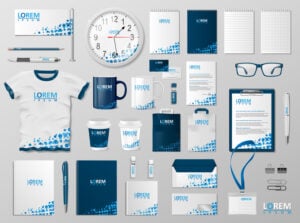Ever feel like you’re working too hard to keep customers coming back? Too often, small business owners make their jobs twice as hard because they don’t take the time to build a brand. They think of branding as optional, instead of treating it as the key to a strong business model.
Imagine meeting a person with no memory and having to introduce yourself over and over again. You would have a hard time building a deeper relationship. Running a company without smart business branding presents a similar problem. How do you convince people to see value in your business if they don’t know who you are and what you stand for?
Branding motivates customers to view your relationship as more than a transaction. And as a result, they believe your products offer more value than competitors. Ready to make a lasting impact on your customers? Here are seven tips on how to build a brand for a small business.
1. Create a marketing plan
Even great ideas need lots of editing. Writing a marketing plan forces you to think about how your business will survive in the real world. Who will buy your products? What will make customers willing to pay your prices? How will you identify and reach the right customer base?
The answers to these questions are the foundation for brand building. Not every product or message appeals to every person. A strong marketing plan helps you decide what image to project to your customers. In other words, learn what matters to your ideal customers, so you can tailor your brand to fit their needs.
2. Give your brand a personality
Big brands have one major disadvantage — they rarely interact with customers one-on-one. In reality, people connect with other people. Small business owners often have more time for authentic interactions with customers. And that means you have more opportunities to back up your branding with real connections.
With this in mind, envision your brand as a real person. Is your brand a tranquil, free spirit? An environmentally-conscious activist? A lover of luxury with an unlimited budget? A conservative, serious-minded manager?
Consider how this fictional person would look, think, and behave. What drives him? What types of people does she spend time with? How would we react to different situations? You can’t develop a successful brand until you know what defines your business.
3. Choose your positioning
You’ll never hit any target by shooting wildly in every direction. The same goes for company branding. Study your top competitors, and make a list of qualities that set you apart. Brand positioning is the process of emphasizing specific traits to make a distinct impression on customers.
Taco Bell doesn’t target people who want fine dining or hamburgers. Instead, the company positions itself to serve people who want fast Mexican-inspired food. Taco Bell also appeals to specific segments of the fast food market. People who like creative food combinations. Convenient ordering options. Late-night snacking. Don’t try to please everyone. Focus on a few customer segments who value what you offer.
4. Fine-tune the customer experience
Delivering an awesome customer experience is one of the best ways to stand out. Customer loyalty often comes from small, thoughtful touches that competitors overlook. Talk to your customers, and find out:
- How they define convenience
- What they find frustrating about the shopping or checkout experience
- What they enjoy most about your products
- What they value most from your customer service team
- What they don’t like about your products
- What they don’t like about your competitors
Not every suggestion will make sense for your business. Get as much feedback as you can, and add a few low-cost perks to your business model. In many cases, you can even charge more by packaging attractive convenience services.
Remember how Netflix doubled prices while gaining more customers? The company streamed its core service, offered options, and created original content. As a result, Netflix snagged customers who were fed up with cable companies. Make your customers’ lives easier, and they’ll stay happy with your business.
5. Don’t copy big brands
Big companies devote a lot of time and money to branding because they have a lot to gain from getting it right. Mimicking the look or messaging of a big brand may seem smart at first. Yet, big brands have more equity. Brand equity is the value a business gains or loses based on customer perceptions.
Consider Oreos. Copycat chocolate cookies with vanilla cream have been around for years. Yet, the Oreos icing has a signature flavor. And other companies team up with Oreos to make their products more appealing. Instead of just selling a cookies and cream shake or donut, brands pay for the privilege of using the Oreos name.
In branding, being a copycat is limiting. Customers will always associate specific traits with the bigger brand. The only way for you to compete is to tempt people with lower prices. And competing solely on price isn’t sustainable for most small business owners.
6. Set brand guidelines
Part of defining your brand is knowing what you’re not. As your business grows, you may hire employees or work with freelance contractors. Having more people represent your brand creates more opportunities for something to go wrong. Setting guidelines creates uniformity and protects your brand from negative associations.
For example, if you want a fun, approachable brand, you should have a style guide for your written content. That way, whoever creates your marketing materials will avoid salesy or stodgy writing.
7. Design cohesive visuals
The visual look of your brand should match your values and positioning. Your products, logo, and website should all tell a clear story about the purpose of your business. Customers expect to get a consistent experience at every point of interaction.
Colors, shapes, and symbols all have specific associations. Choose elements that evoke positive emotions while defining your unique brand personality. Consider the Goodwill logo. Blue is associated with trust, integrity, and expertise. The logo image and lettering incorporate smiley faces, adding a playful touch. The elements all work together to brand Goodwill as a longstanding, trustworthy company that cares about people.
Learning how to make a brand is challenging, and it’s common to hit roadblocks along the way. Nowadays, businesses have much more competition, so it’s hard to be unique.
Focus on serving customer needs in a new way, and don’t be afraid to make adjustments as you grow. Strong business branding gives you the power to evolve without losing your loyal following. Put in the effort now, and you’ll spend less time trying to hold onto wandering customers.
> If you’re working on building your brand, don’t forget a unique logo design for your business. Take a look at some of our logo maker templates to get some ideas.







